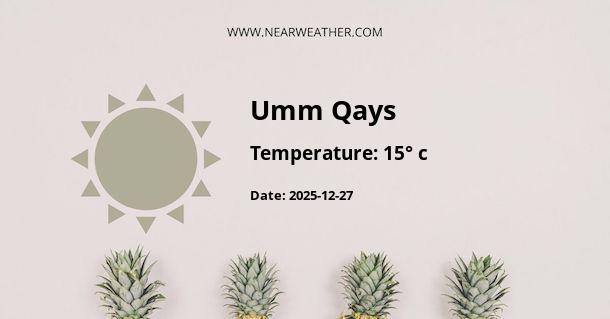Introduction
Located in the far north-west of Jordan, Umm Qays, also known as Gadara, is a captivating site that offers a unique blend of ancient history and natural beauty. However, what also sets Umm Qays apart from other tourist destinations in Jordan is its unique weather and climate that changes dramatically throughout the year.A General Overview of Umm Qays Climate
Umm Qays experiences a Mediterranean climate, characterized by hot, dry summers and cool, wet winters. The region is situated at an elevation of about 378 meters above sea level, which significantly affects its temperature and precipitation levels.
Seasonal Climate in Umm Qays
Spring (March - May)
Spring in Umm Qays is generally mild and pleasant. The average high temperature ranges between 18.5°C (65.3°F) and 25.6°C (78.1°F), while the average low temperature ranges between 10.6°C (51.1°F) to 14.9°C (58.8°F).
Summer (June - August)
Summers are typically hot and dry with an average high temperature ranging between 30.9°C (87.6°F) and 32.4°C (90.3°F). However, the average low temperature remains relatively cool, ranging from 20.1°C (68.2°F) to 22.0°C (71.6°F), providing a refreshing contrast to the daytime heat.
Autumn (September - November)
Autumn sees a gradual cooling of temperatures. The average high temperature drops from 30.3°C (86.5°F) in September to 21.1°C (70°F) in November. The average low temperature also decreases, ranging from 19.3°C (66.7°F) to 12.6°C (54.7°F).
Winter (December - February)
Winters in Umm Qays are typically cool and wet with occasional snowfall. The average high temperature ranges between 13.5°C (56.3°F) and 15.0°C (59°F), while the average low temperature varies between 6.0°C (42.8°F) and 7.5°C (45.5°F).
Annual Rainfall in Umm Qays
Umm Qays receives an annual average rainfall of about 400-600 millimeters, most of which falls between November and March. The wettest month is typically January, with an average rainfall of 104.2 mm (4.1 inches). The driest month is typically July, with virtually no rainfall.
"Umm Qays offers a unique combination of Mediterranean climate characterized by hot, dry summers and cool, wet winters. The seasonal variation in weather allows visitors to experience the region in different hues and moods."
Best Time to Visit Umm Qays
The best time to visit Umm Qays depends largely on the visitor's preference. If you prefer warm weather, the best time to visit is during the summer months (June - August). However, if you prefer cooler weather and don't mind a bit of rain, the best time to visit is during the winter months (December - February). Spring (March - May) and autumn (September - November) also offer pleasant weather for sightseeing.
Conclusion
In conclusion, Umm Qays offers a unique blend of ancient history and natural beauty that is further enhanced by its distinctive weather and climate. Whether you are a history buff, a nature lover, or simply a traveler looking for a unique travel experience, Umm Qays is sure to leave you spellbound with its rich history, spectacular landscapes, and diverse weather patterns.
A - Umm Qays's Latitude is 32.653481 & Longitude is 35.685398.
A - Weather in Umm Qays is 20° today.
A - Climate Conditions in Umm Qays shows clear sky today.
A - Humidity in Umm Qays is 78% today.
A - Wind speed in Umm Qays is 8.96 km/h, flowing at 223° wind direction. today.
